|
Cheryl Fenner Brown, C-IAYT, E-RYT 500 This article also appeared in the Yoga U Online Wellness Blog, August 2019 Your nervous system is made up of two parts that relay information between your brain and the rest of your body, the central nervous system (brain and spinal cord), and the peripheral nervous system (all other nerves. Neuropathy occurs when these nerves are damaged. Peripheral neuropathy, resulting from damage to nerves outside of the brain and spinal cord, can cause changes in sensation such as tingling, pain, numbness and weakness especially prevalent in the arms, legs, hands and feet. When it occurs in the lower body, there may be issues with constipation or balance when proprioceptive feedback from the lower extremities is interrupted. Symptoms may be different from person to person depending on which nerves are damaged and the severity. Why Do Cancer Patients Get Neuropathy? Unfortunately, neuropathy can be caused by all allopathic cancer treatments and unfortunately cannot be cured. Surgery causes neuropathy when nerves are disturbed and from the resulting inflammation. Radiation causes neuropathy when treatment damages nerves; neuropathy of the hands and arms is common in breast cancer patients who undergo radiation. Certain chemotherapy drugs may cause neuropathy, especially at higher doses. And the cancer tumor itself may press on nerves causing similar nerve damage and neural symptoms. When sensory nerves are affected - those that control your sense of touch - you may feel tightness, discomfort when things touch your skin, numbness, an inability to feel temperature changes, tingling, burning, electric sensations, or pain in the hands in feet. You may even have challenges knowing where your hands or feet are in space (proprioception) which may cause difficulty grasping things or with your balance. When motor nerves are affected - those that relay information between the brain and body - you may have trouble walking because the feet and legs feel weak or heavy. Not only balance, but coordination is compromised, and everyday activities such as dressing or using your phone may be impaired. And many patients report that symptoms continue to worsen months or even years after treatment ends. When autonomic nerves are affected - those that govern bodily functions - you may have trouble with blood pressure and body temperature regulation. Other issues may arise with swallowing and digesting food, or when urinating or defecating or with sexual function. It is important to inform your oncologist if you begin to experience any of these side-effects. Yoga and Neuropathy The good news is that there are many ways that yoga can reduce the suffering associated with neuropathy. The relaxation effects of breathing and regular yoga practice can help you learn to handle the distraction and discomfort of neuropathy. And the movement aspect of the practice can help to reduce the uncomfortable sensations you may be experiencing. There are also mudras that help to circulate the vital force of the body (prana) and stimulate the extremities. In fact, several clinical trials are currently underway to explore the effectiveness of yoga to treat neuropathy in breast cancer patients. Yoga Practice Tips
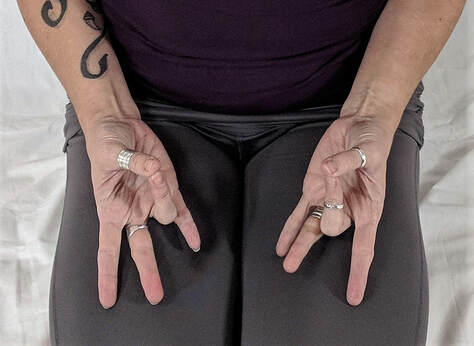 Repeat Intention with Vyan Vayu Mudra Begin in a comfortable seated position with your hands on your lap. With your left hand, touch the tips of your thumb and middle finger together while extending your other fingers. With your right hand, touch the tips of your thumb and ring fingers together while extending your other fingers. Rest the backs of your hands on your thighs in Vyan Vayu Mudra. This gesture improves circulation to the extremities, enhances body awareness and promotes the flow of vital energy through the body. 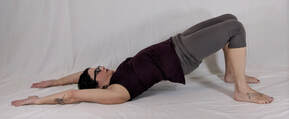 Bridge Flow (Setu Bandha Vinyasa) This reclining bridge flow is a simple series of movements that may help to increase pranic flow and circulation. It is best done on the floor but can also be done on a bed.
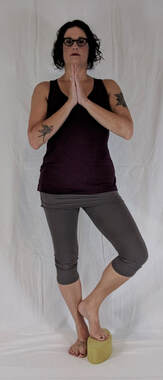 Tree Pose (Vrksasana) This common standing pose is helpful for building body awareness, stability and balance.
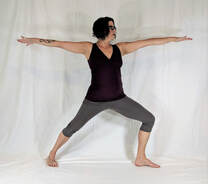 Warrior II Flow (Virabhadrasana II Vinyasa) Moving through variations of Warrior II (Virabhadrasana II) can also help with stability, proprioception, strength and balance.
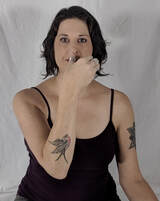 Alternate Nostril Breathing Breathing alternately into the right and left nostrils can help to calm the nervous system which might make neuropathy symptoms seem less intense. It also increases communication between the right and left hemispheres of the brain to stimulate the central nervous system.
 Body Scan The body scan, or rotation of consciousness, is a guided sensory journey through the different parts of the body. It increases body awareness, eliminates mental chatter, and engages the witness consciousness. You engage as many channels of communication as possible to keep the mind focused - auditory by listening to the teacher’s voice, speech by repeating the body part, visual by imagining the part externally, proprioceptive by feeling the part internally, kinesthetic by sensing movement from one place to the next. The scan connects the origin of the motor nerves in the brain to the ending of the nerves in each part. As you go through the rotation of consciousness, you are activating parts of your brain associated with parts of your body which in effect, relaxes the mind by relaxing the body.
References
0 Comments
Cheryl Fenner Brown, C-IAYT, E-RYT 500 This article also appeared in the Yoga U Online Wellness Blog, July 2019 Anxiety is one of the most prevalent side-effects along the entire spectrum of the cancer journey. Nearly all patients will experience anxiety at one point or another including after receiving a diagnosis, anticipating and receiving treatment, affording treatment, anticipating recurrence, ending treatment and becoming a long-term survivor. For many the fear of recurrence is very real and something that does not diminish with time. While the rate of recurrence varies depending on the type of cancer from early treated breast cancer as low as 5% to glioblastomas and ovarian cancers approaching an 85% recurrence rate or higher, up to7% 0f patients develop a disabling fear of recurrence that severely impedes quality of life. Stress, Anxiety and Cancer Cancer patients may experience generalized anxiety or other diagnoses such as phobias, panic attacks, OCD, health anxiety disorders and PTSD. Symptoms of these may vary but include increased heartrate, shortness of breath, muscle tightness, heightened pain, insomnia, sweating, nausea, restlessness and irritability. Also, how patients feel about their stress and anxiety impacts how much the stress affects their physical and mental health. One study out of Harvard reported that those who had high levels of stress and believed stress negatively impacted their health had 43% increased premature death rates over those who did not believe their high levels of stress was harmful. The Stress Response & Immunity The stress response or commonly called “fight or flight” response turns off the parasympathetic nervous system and reduce bodily functions not necessary for immediate self-preservation. This includes the lymphatic system, which in turn slows the immune response. As far back as 1965 psychiatrist George Solomon published some of the first findings in the field of psychoimmunology studying the link between stress levels and immune responses. When stress is perceived as harmful and chronic it can inhibit immune function. However, when stress is perceived as an opportunity to rise to a challenge, it does not. When we experience as stressful event, whether it is the diagnosis of a life-threatening disease, or something as commonplace as getting cut off in traffic, the body responds automatically by secreting stress hormones. One of these is cortisol which raises blood sugar and metabolizes white blood cells to provide energy for the “fight or flight” response. Unfortunately, when stress becomes chronic, cortisol levels remain high even during rest and this can decrease immunity by inhibiting T-cell production and our T-cells are what protect the body from invading viruses, allergens and from mutated cancer cells. When a challenge is perceived adrenaline is also produced. Adrenaline increases blood pressure and heartrate to create a rush of energy so we can respond to the challenge. But over time, sustained production of adrenaline causes a higher than normal baseline to be set by the body which taxes the organs, increases insulin production, and keeps blood pressure high. Tend and Befriend Response Fortunately, our bodies have a built-in mechanism for stress resilience, the hormone oxytocin. Also secreted as part of the stress response, oxytocin protects the cardiovascular system from the effects of stress, it works as an anti-inflammatory and keeps muscles more relaxed. Emotionally, oxytocin encourages us to seek support from others and helps us to notice when others are struggling, and when we do, more oxytocin is released. Particularly for women, the “tend and befriend” response is tied to higher levels of oxytocin and causes us to ‘tend’ to those around us who are in need, and ‘befriend’ by seeking out social support. Better stress outcomes can be expected when patients have emotional and social support in place including support groups, therapy, education and wellness communities including yoga class communities, especially yoga classes for people managing cancer. Perhaps this speaks to why more women tend to seek out social support systems when undergoing diagnosis and treatment for cancer. How Yoga Helps Anxiety The good news is that yoga and other mindfulness practices modulate the stress response by lowering heartrate, blood pressure and respiration rates, and increasing heart rate variability which is an indicator of how well the body responds to and recovers from stressful events. More and more studies are being conducted showing the positive impacts of consistent yoga practice on mental and emotional well-being in cancer patients. Specifically, yoga has been shown to improve mood states, symptom reduction, stress reduction and improved quality of life. Besides improving these measurable health markers, yoga can lead to a sense of empowerment and mastery over the body and mind which can be an important factor in reducing stress and anxiety. What follows is a simple sequence of yoga practices including setting intention, a mudra for anxiety, a simple sound practice to help calm the mind, a supported version of Balasana (Child’s Pose) to help you draw awareness inward and a calming pranayama practice. Done together these practices can help you to cope with the anxiety caused by diagnosis, treatment or survivorship and allow you to feel more like yourself. Yoga Practice Tips
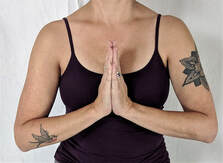 Setting Your Sankalpa with Anjali Mudra Intention setting, or creating a sankalpa, is an important first step toward using yoga as a healing practice. It serves as a reminder of your goals during this time.
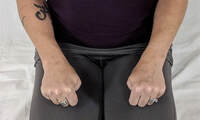 Adhi Mudra for Anxiety Adhi translates to “first” because this mudra is the first mudra we do in the womb. It is a self-soothing gesture and comforts us during anxious times. Adhi mudra draws the excess mental activity down into the body where it can be processed and grounded. I also call this one of the “sneaky” mudras because you could easily hold your hands in this position during a difficult conversation and no one will know that you are doing something to ease your anxiety.
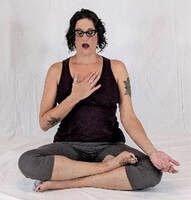 Vowel Spiral Using your voice to create a shift in your mental state is a powerful tool to combat anxiety. This practice uses simple vowel sounds that cause vibration in specific parts of the torso and head. As awareness is drawn into these areas, the mind can be freed from circular thinking that might cause anxiety. As you chant, focus on what the sound feels like in the body, how the vowels sound, and how smooth the tone is. You may notice breaks and warbling in the tone if your mind wanders or if your exhalation is not smooth. Work to smooth out the tone and make sure that you stop sounding before you run completely out of breath, so you are left feeling relaxed, not breathless and rushed. Chanting simple sounds is one of the fastest, most effective ways to center the mind and emotions. When you are anxious you can imagine that your cells are vibrating in dissonance at an atomic level. When you chant, you bring your atoms into resonance and harmony and you can truly feel the difference almost immediately. Give it a try!
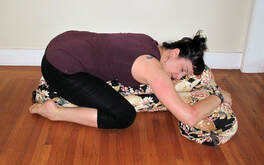 Balasana (Supported Childs Pose) Coming into a fetal position can feel like a balm for frayed nerves. It enables you to turn your awareness towards the internal landscape of sensation, breath and thought and away from the things outside of yourself that may be causing anxiety and stress. However, this pose can be difficult if the knees or hips are not comfortable in deep flexion. If you have access to bolsters or pillows, you can support your hips, thighs and torso so that Balasana (Supported Child’s Pose) can be maintained for several minutes in comfort and relaxation.
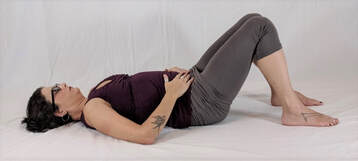 Rechaka Kumbhaka Pranayama (Exhale Retention) Conscious breathing is a simple yet effective way to shift your mindset when you are worrying or feeling anxious. It is an amazingly powerful tool that is always there for you when you have a few moments to focus on your breath. Bringing awareness to a slow, relaxed exhalation will activate the parasympathetic nervous system helping to reduce the effects of anxiety by reducing stress hormones, heartrate and blood pressure. The practice of lengthening the exhalation can increase the stress-reducing effects even more.
Repeat this pattern for several minutes, then return to your normal everyday breath pattern.  Savasana (Relaxation Pose) It is important to give yourself a few minutes at the end of your practice to rest in stillness and silence so that the gifts of the practice can be fully integrated into your body and mind.
References
Cheryl Fenner Brown, C-IAYT, E-RYT 500 Yhis article also appeared in the Yoga U Online Wellness Blog, May 2019 One of the most distressing side-effects of cancer treatment is lymphedema, a swelling of the extremities caused by damage to the lymphatic system. The lymphatic system is part of the immune system and consists of nodes, vessels and organs that transport lymph throughout the body. Lymph transports white blood cells through lymph nodes which are grouped in the throat, underarms, abdomen and groin. These nodes store cells that help to fight infection and filter the lymph before it returns to the bloodstream. If cancer treatment damages or removes lymph nodes, lymph builds up in the surrounding tissue causing painful swelling, or lymphedema. During breast cancer treatment, lymph nodes are often removed and tested for cancerous cells. The symptoms of lymphedema may occur immediately or up to 5 years after treatment. According to one survey, between 50-75% of women who had lymph nodes removed as part of breast cancer treatment worried about developing the condition while less than 20% developed the condition (1). Patients with lymphedema can experience a range of symptoms besides swelling of the limb and digits including pain, limited range of motion, increased risk of infection, sensitivity, hardening or thickening of the skin. (2) Lymphedema treatments include manual lymph drainage, elevation of the affected limb, compression garments, breathing exercises and movement. (3) Yoga and Lymphedema Unlike the circulatory system which has the pumping heart to move blood through the vessels, the lymphatic system relies on the body’s movements to circulate lymph. The deep diaphragmatic breathing and simple repetitive movements of the hands, arms, neck, torso and hips that are involved in many forms of yoga all help the lymph to flow optimally. Yoga also helps to increase range of motion and strength which can help to counter the impact of lymphedema, so long as the yoga is practiced slowly and gently. There are a few yoga poses that are contraindicated for those with lymphedema; handstand (adho mukha vrksasana), forearm balance (pincha mayurasana), downward-facing dog (adho mukha svanasana), headstand (sirsasana), shoulderstand (sarvangasana), and plow (halasana) all put too much pressure on the arms, shoulders and neck and should be avoided. If the lower extremities are affected, poses that create too much compression on the legs should also be avoided such as lotus (padmasana) or child’s pose (balasana) with deeply bent knees. Yoga Practice Tips
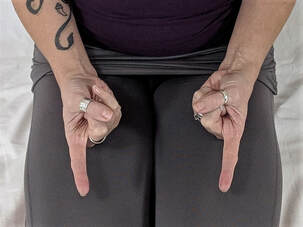 Intention with Anushasana Mudra One of the tools of yoga is practicing mudras which link the physical and energy bodies. Here use Anushasana mudra to activate vyana vayu, the pranic current theat moves from the center of the body towards the extremities and supports lymphatic circulation.
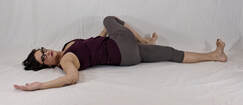 Reclining Floor Flow The reclining floor flow is a simple series of movements that massages the lymphatic structures in the armpits, abdomen and groins. It can also alleviate pain in the hips, lower spine and shoulders. This practice can be done on the floor or on a bed.
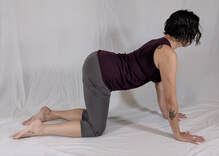 Cat/Cow (Marjaiasana/Bitilasana) This common series of poses is a simple way to move energy and lymph throughout the torso and can be done kneeling on the floor or seated in a chair.
 Child’s Pose to Extended Hero’s Pose (Balasana to Utthita Virasana) Moving from Child’s Pose (Balasana) to an extended spinal position mobilizes prana, or vital energy in the body and can help to activate stagnant lymph.
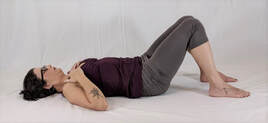 Three-Part Breath (Dirga) Breathing deeply is part of traditional lymphedema treatment as it increases the movement of the diaphragm and massages the lymph nodes located deep within the abdominal cavity. The full yogic breath, or Three-Part Breath can be practiced while seated in a chair or reclining on the floor or bed. I often imagine the breath like an elevator car moving up and down along an elevator shaft as I practice this pranayama.
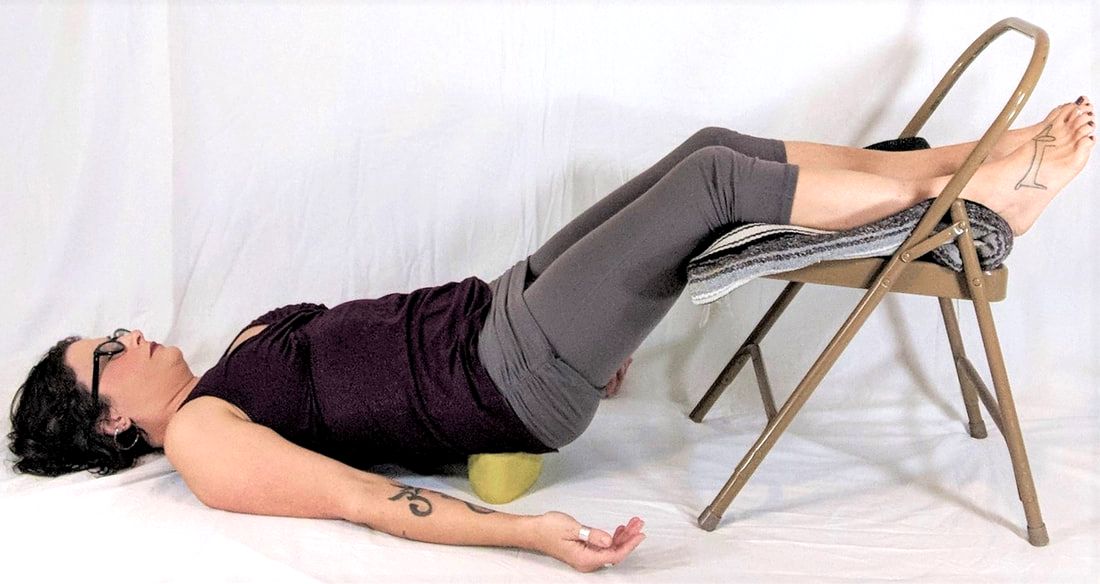 Instant Maui Elevating the legs encourages lymphatic drainage back toward the torso and is very easy to do at home. Some doctors recommend that the legs be elevated above the heart for at least 30 minutes 3-4 times a day for maximum benefit (4). Take care when positioning your body to be sure that your feet are elevated above your knees, your knees above your hips, and your hips above your heart to ensure excess fluid travels back toward the torso where it can be re-circulated into the blood stream. This posture is also mild inversion that provides a change in our perspective encourages deeper breathing, energy absorption and relaxation. Find a piece of furniture in your home such as a soft chair, sofa seat or ottoman to use for support.
Even though lymphedema can be an uncomfortable side-effect of cancer treatment, these simple yoga practices can boost immunity, release tension, increase lymphatic drainage and help the body to find more balance. Happy practicing and namaste’.
References
|
Index:Archives:
September 2022
I attend Cheryl's class regularly and feel that my practice has improved immensely over the past few years due to her expert coaching. Her teaching style is clear and compassionate and her previous experience in teaching adults is evident in her organized approach and easy to understand instructions. I also appreciate that Cheryl not only teaches us about how to correctly position ourselves, but also touches on many aspects of yoga philosophy, which in turn has deepened my personal practice and heightened my awareness of the connection between mind and body, breath and relaxation. |

 RSS Feed
RSS Feed
